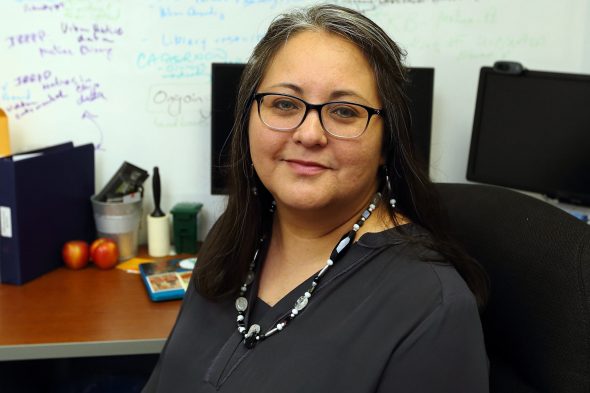UIC to offer in-state tuition to students from any of the 573 tribal nations in US

American Indian and Alaska Native students have the lowest representation of any group on college and university campuses across the nation, according to U.S. Department of Education statistics.
The University of Illinois at Chicago is trying to remedy this by beginning to offer in-state tuition this fall to students who are members of any of the 573 tribal nations recognized by the Bureau of Indian Affairs.
While nationally the numbers of minority groups, including black and Hispanic students have climbed and reached double digit percentage rates, the same can’t be said for American Indian and Alaska Native students.
Between 1976 and 2017 the percentage of students in post-secondary institutions who identified as American Indian or Alaska Native hovered at about 1%, but more frequently dropped below that threshold, according to the National Center for Education Statistics.
In comparison, the number of black students rose to a high of 15% in 2010 and is currently at more than 13% of college students. Hispanics rose to a high of nearly 19% in 2017 and are estimated to increase.
Like other universities, UIC has a very low number of American Indian and Alaska Native students and officials hope that providing the in-state designation will increase the numbers of these students.
Eligibility for the tuition offer isn’t based on students’ state of residence, such as Oklahoma, Alaska or any other state with a large American Indian population. If their tribes are listed as one of the 573 federally recognized entities, the students will be eligible for in-state tuition.
Students will still have to meet all of UIC’s admission standards, including test scores and grade point averages.
“What we are doing is taking away one of the financial roadblocks, which is out-of-state tuition and recognize the historic tie between Illinois with the American tribal nations,” said Kevin Browne, vice provost for academic and enrollment services at UIC. “One of the things we wanted to do to create a fairer playing field for Native Americans is to recognize that their nations did not recognize state boundaries.”
The in-state tuition can mean as much as a $13,000 to $14,000 per year savings, said Oscar Rodriguez, associate vice provost for recruitment and outreach at UIC. Rather than being charged the base non-resident tuition of $23,800, the eligible students will be charged $10,584 as a base tuition before federal Pell grants as well as any other aid they may have received.
In addition to aid, campus officials point to the Native American Support Program that has existed at UIC for nearly 50 years as an assistance to American Indian and Alaska Native students trying to fit in on campus.
Currently there are approximately 600 students at UIC who identify as American Indian/Alaska Native and multiracial, said Cynthia Soto, director of the Native American Support Program at UIC. Soto is a member of the Sicangu Lakota Nation and a UIC alumna.
While historically the native Americans indigenous to the region included the Potawatomie, Ojibwa and Odawa tribes, they were driven out of Illinois and the Bureau of Indian Affairs does not list any tribes in Illinois. Nearby states such as Wisconsin and Michigan each list at least a dozen recognized tribes in those states and Indiana also lists one tribe.

“It’s definitely needed, for UIC to even embark on this is wonderful,” Soto said. “We are on native land, this is Indigenous land and just because the state of Illinois has no federally recognized tribal nations does not mean that UIC should not have a responsibility and commitment to native people.”
Cheryl Crazy Bull, president and chief executive officer of the American Indian College Fund, said there is a need for this assistance and she said that that while some other institutions offer similar in state tuition, the number is less than 20 across the country.
She cited statistics that show that while other groups are gaining footholds on college campuses across the country, the numbers of American Indian and Alaska Native higher education students is dropping. She cites the cost of tuition and the lack of support services on many campuses as the reason for the low numbers.
“Increased access for native students by offering financial incentives is a great way to improve educational equity and remedy historic barriers to education experienced by indigenous people,” Crazy Bull said. “When an institution takes this progressive step, its leaders show foresight and demonstrate that they are willing to take action that supports vision and opportunity.”
UIC student Ashley Rouse, a member of the Choctaw Nation of Oklahoma, said that given the history of indigenous people and the use of the Indian Removal Act of 1830, which forced native people into reservations on lands that they often had no connection to, UIC’s initiative acknowledges that for “indigenous people this country is our home.”
Rouse, who will be entering her third year at UIC this fall, said that the initiative will spur more students like her to give UIC a strong look. She said the university’s support program was the reason why she chose UIC.
“Knowing that you’ll be surrounded by your culture and other individuals that come from the same or similar backgrounds is very comforting,” she said. “I think it’s only fair to give the native people, especially native youth, the opportunity to succeed at a university that offers a support system for them. I’m sure it will help others make the decision to pick UIC as their college of choice as well.”
